This week, in keeping with our competition theme for May, I am showing you an old school clothing modification to help your draw stroke. This is going to be very helpful if you want to shoot IDPA style matches or if you just choose to carry concealed under a cover garment.
The biggest problem with a cover garment has always been getting it out of the way so it does not foul your draw stroke. To solve this issue, just run out to Home Depot and pick up some brass washers and Shoe Goo.
All you’re going to do is use the Shoe Goo to attach a total of six washers to the inside of the shirt, at the bottom (below the waistline), three on either side of the placket (that vertical panel of fabric where the buttons connect). Piece of cake!
For an overshirt, I chose to modify the new Blackhawk 1730. This is a lot more inconspicuous than a fishing vest. Plus, no one will confuse you with an extra from a Chuck Norris movie.
The shirt is already pretty much set up for success out of the wrapper. It features snaps with false button fronts to make opening it lighting fast. It also comes with a water-resistant finish. With my little gunfighter trick added on, the Blackhawk 1730 is an excellent choice for concealed carry.
For more information on Blackhawk 1730, make sure to visit the website.
[one_half]
[/one_half]
[one_half_last]
[/one_half_last]
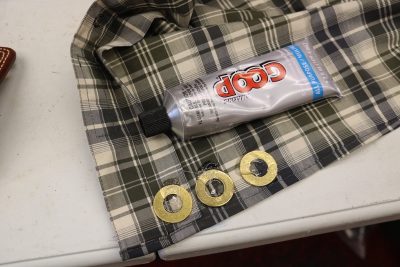
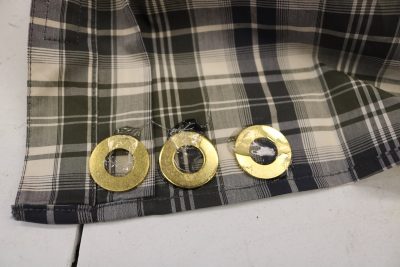
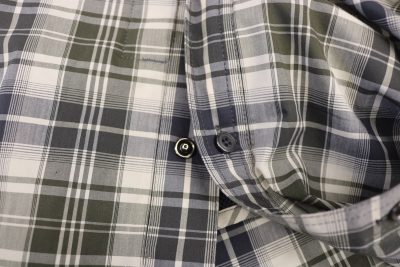
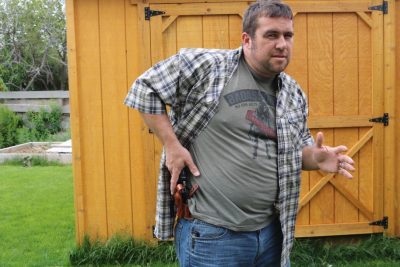
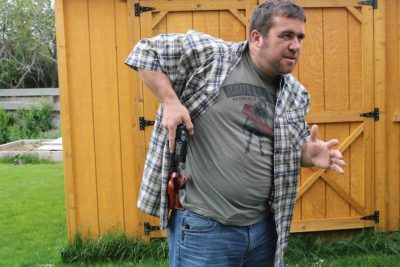
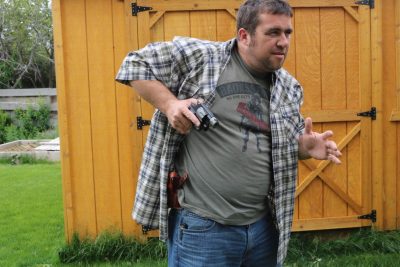
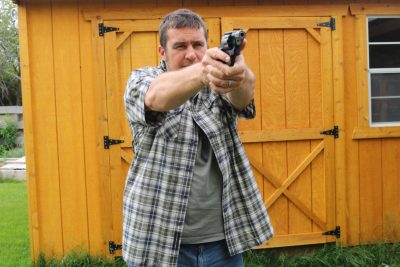
This has been attempted MANY times by students and instructors on ranges over the last few years, what they have found about the “whipping your shirt back” technique with weights is that the shirt is likely to come back and get in your way whilst drawing and is no longer recommended. Its better to use your off hand to hold your shirt back whilst drawing and let it fall naturally after the firearm is out.
Why not just user quarters instead of washers. That way when the shirt wears out you “get ‘er money back” at least from the ballast!
“Gunfighter” “The name Gunfighter doesn’t mean reckless, wanton destruction. It means finding a solution for even the most difficult situation.” MOUNTAIN HOME AIR FORCE BASE, Idaho — Across the Air Force, Mountain Home Air Force Base is known as the “home of the Gunfighter.” Airmen here refer to each other as Gunfighters and many of the buildings carry the moniker as well. But, where did the name come from? Gunslinging cowboys from the Wild West have little to do with precision, dual-role fighter jets, right?
“The name Gunfighter can be traced back to a single man, retired Maj. Gen. Frederick “Boots” Blesse, who was laid to rest at Arlington National Cemetery in Arlington, Va., at 8:45 a.m. today. His story is one of adaptability, innovation and excellence, a tradition carried by the 366th Fighter Wing to this day.
Blesse earned nearly 40 decorations during his career, but those medals were just the result of who he was. He was an innovator, a flying ace, a Gunfighter and above all, an Airman.
His part in the Gunfighter heritage started in Da Nang Air Base, Republic of Vietnam, in April 1967. As director of operations for the 366th Tactical Fighter Wing, he flew more than 150 combat missions during the Vietnam War flying F-4C Phantom II fighter jets.”
I quote from an article from Mountain Home AFB. Excellent read! My sincere thanks to all that served in military, that I and we enjoy the freedom we have today. Thanks to you , Clay, as well!!!!
Wow….a blast from the past. I drank many a beer at “The Gunfighter Grill” back in the 80s during my time in the 366th CRS.
been doing something similar for years for IDPA. I use one of my old automotive workwear uniform shirts as cover garment, cut a little slit near tail and slip a 9mm round into slit. Hem is enclosed on my shirts, no need for glue, and pops right out before I leave the range.
I have small stainless steel weights sewn into the corners of all my cover clothes, I have for years now.
I learned to use stainless parts when the green from the brass, or the rust from the regular metal ruined my other stuff. 😉
It’s really worth the few bucks extra it costs in the long run.
Lots of people felt as you do about faulting subjective IDPA cover lines. IDPA, as of 2017, now uses ground markers – much like USPSA – for establishing the limits of shooting positions while using cover. Much better.
However, adding weight to the cover garment is forbidden by IDPA rules and will get you disqualified if discovered.
I’ve seen concealment shirts with small pockets in the hem there so you can drop washers or other weights in, and remove them for washing. If you have minor sewing skills or know someone who does you could add pockets like that pretty easily. Velcro closure could keep the weights in if you’re worried about dropping them.
Waaay too much weight with washers and that’s totally unneeded and can be seen as a way to detect a concealed weapon.
A much better trick is to cut a very small hole in the seam of the shirt in the same spot, and put a 5-8″ long piece of weedeater trimmer string inside that seam. Close the seam with a dot of super glue. That way their is no weight, but it has rigidity to ba able to sweep it out of the way quickly and efficiently.
I have a major problem with the title of this piece. “Gunfighter Tip of the Week: Shirt Modification to Improve Draw Stroke”. GUNFIGHTER??? Since when is properly armed and permitted citizen now referred to as a “Gunfighter”. “Draw Stroke”???The last thing we want to do is create the impression that by supporting 2nd amendment rights, concealed and open carry that this is a wish to return to the old West. That is what that term conjures in the minds of most. I conceal carry and the last thing I think of myself is as a “Gunfighter”.
I like the tip, I think it’s valid, but it’s couched in wrong terms in my opinion (which as I always say is worth what you paid for it).
Don’t give in to political correctness… seriously… Next thing you’ll stop using “he” or “she” because you might offend someone… As soon as you give in, the status quo changes. I get your point, is valid, but also is giving in. Pull them to us, don’t give them slack to take away from us.
you’re being a PC dweeb here…Clay probably calls himself a gunfighter because HE IS A GUNFIGHTER!. He’s a Green Beret and also served as a marine sniper. He literally has been in numerous gunfights. I’d say he’s more than qualified to use that terminology.
I like the concept, but will probably use Velcro instead of glue. This to allow removal when desired (like in the dryer.) I do have a couple denim western shirts with snaps and very long tails (daughter with sewing machine will fix that!) I believe we have a plan!
British SAS would keep a spare magazine in their strong side pocket. Their draw technique was to take a short side step which would cause the weighted side pocket to swing outward clearing the jacket out of the way for the draw. Good modification Clay. If you are not wearing a cover with pockets.
Whew Clay move down here to Florida and get that belly tan. Great article. I don’t shoot competition but I do conceal carry when I’m not on duty. Hmmm a Hawaiian shirt with brass washers. Your such a fashinista dude.
Tj
“A hero remembered will never die”
What about in the dryer will that shoe goo melt
Don’t know if the goo will melt, but your hearing protection will come in handy once you start tumbling 6 brass washers in your dryer. But if the noise and possible dents in your dryer aren’t a concern, sew the washers in as opposed to gooing them.
If I decided to do this, I’d put the shirt in a pillow case (or bag with tie strings) along with a dry towel before putting it in the dryer.
P.S. I don’t think he mentioned it, but the washers might also prevent the shirt from blowing open on a windy day and exposing your gun!
. . . always one thinking out of the box! Great question and the answer is definitely Yes! So the solution is never wash it and the stink alone should keep the bad guys away! 😉
You could always tack stitch the washers in a few places.
Same concept as one taught to me by an old school NYPD Detective – when wearing a suit jacket he always kept a half roll of quarters in his draw-side pocket. Achieved the same result, and he always had a quarter for a pay phone if he needed one. That’s right- a pay phone. That’s how old school he was.